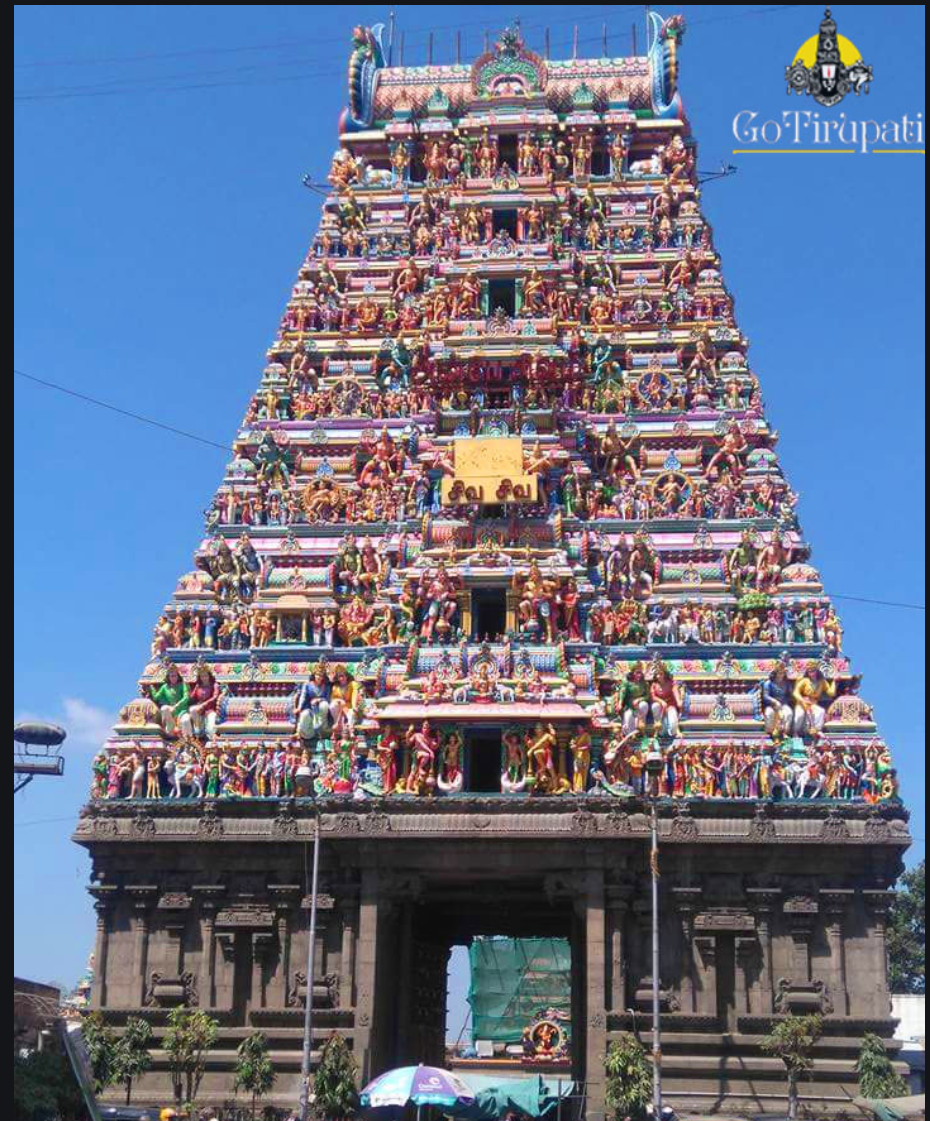
Can religion and science co-exist?
As long as the hoi polloi are kept happy
Mirza returns to the cafe to retrieve Jeff and Margo right as they finish their dessert and strolls them leisurely to the car before climbing in the driver’s seat and taking off in wild banshee style. They drop Jeff at a non-descript office building, in the middle of a nest of non-descript buildings. Good thing they are numbered, Margo thinks. Then, they head towards their site-seeing tour – stymied around nearly every bend in the road by cows sauntering across the road. Margo asks, “can’t they do something about corralling the cows?”
“Cows are very sacred here and it is believed to be good karma to feed the cows. It is a crime to hurt them and if not punished by the police, perpetrators are punished by vigilantes.”
Looking in her bag, Margo sees that she has an apple. “I think your welcome kit should include a big bag of apples for bribery”. Margo finds the juxtaposition between the high technology and the old customs to be a total conundrum. Then again, she thinks, religion everywhere is mostly grounded on old customs, that perhaps made some sense a thousand years ago: fish on Friday, don’t eat pork. Why should here be any different? Just different religions with different customs.
She gets out of the car, walks to the cow directly in front of their car and coaxes it out of the street with the apple. Back in the car, she tells Mirza, “I can feel the good karma coming my way already, or, maybe I just we my undies.”
“Don’t worry, we are only about five cows away.” Mirza drives past the cow and they drive on.
“Do you know the expression, “Don’t have a cow??” asks Margo. “Sounds sacrilegious to me.”
“We have a similar saying here, “Don’t have kittens.” I believe it came from the British – perhaps they changed it from cow to not insult us. Or maybe cow came first and you Americans changed it from kitty since you revere them.”
Margo’s about to protest, when she thinks about all the cat videos her patients send her and realizes that, hot-damn, he’s right. Ever so slowly, cow by cow, they make it to the Kapaleeshwarar Temple, the largest tourist attraction in Chennai, luckily before Margo wet her pants.
As they get out of the car and head towards the entry, children start noticing Mirza’s multiple hands and they begin to follow him as if he’s the pied piper. Margo sees that Mirza is quite nonchalant about this; it must be very common.
“The temple was built in the 7th century and then rebuilt in the 1600s,” says Mirza, starting the tour.
“I never realized the temples could be so colorful!” Margo says while staring up at the entrance. “It looks like it was built by two different species,” she says marveling at the dichotomy between the bottom of the entrance which looks rather Roman or Greek and the top which looks like a psychedelic cuckoo clock with layer upon layer of colorful figurines. “It had to take a very, very long time to carve and paint all of that.” Margo said, also thinking that each layer must tell a story.
“This is called a gopuram, the classic entrance to Dravidian temples. The word comes from gawa and puram, meaning the place from which all the energy that exists in all living beings comes inside.
Looking more closely, Margo sees that all of the carved goddesses have 4 and more arms, and she asks Mirza to explain the significance. Normally, she is much better prepared before a cultural outing.
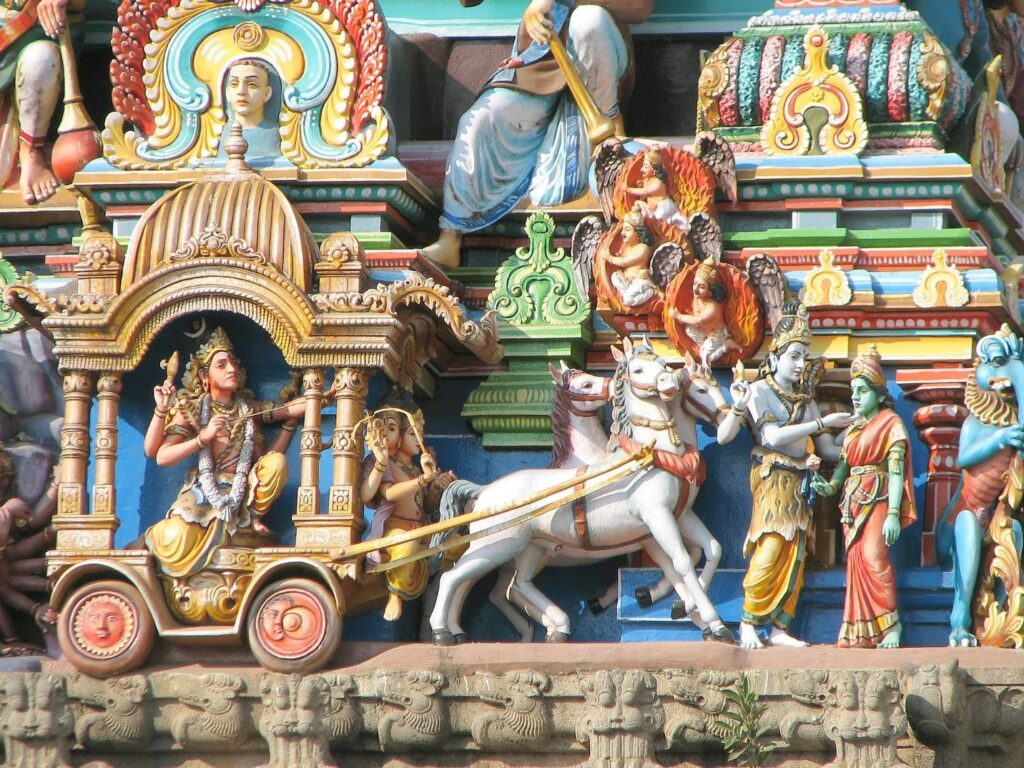
I thought that would be the first thing you noticed! And it is why those of us with multiple arms are so revered here in India. The multiple arms are meant to depict the gods’ immense strength and power to perform numerous acts at a single time. When the hands are pointed up, it shows protectiveness, when the hands are pointed down, it shows charity. Often the hands hold an object to depict other powers, as well. For example, a rope is used to keep people from straying from the faith.”
“I loved that multi-tasking is revered! But, I would think that would make Indians worship women, not cows.” Says Margo as she and Mirza wonder inside, the kids following close behind.
“Ah, but indeed we worship female gods! This temple is dedicated to Parvati, the Hindu goddess of fertility, love and beauty, as well as divine strength and power. You can see her there – that representation is called the argha.” Mirza points to a statue of a mostly naked, shapely lady with a tiny waste and large, rounded breast that puts Barbie to shame.
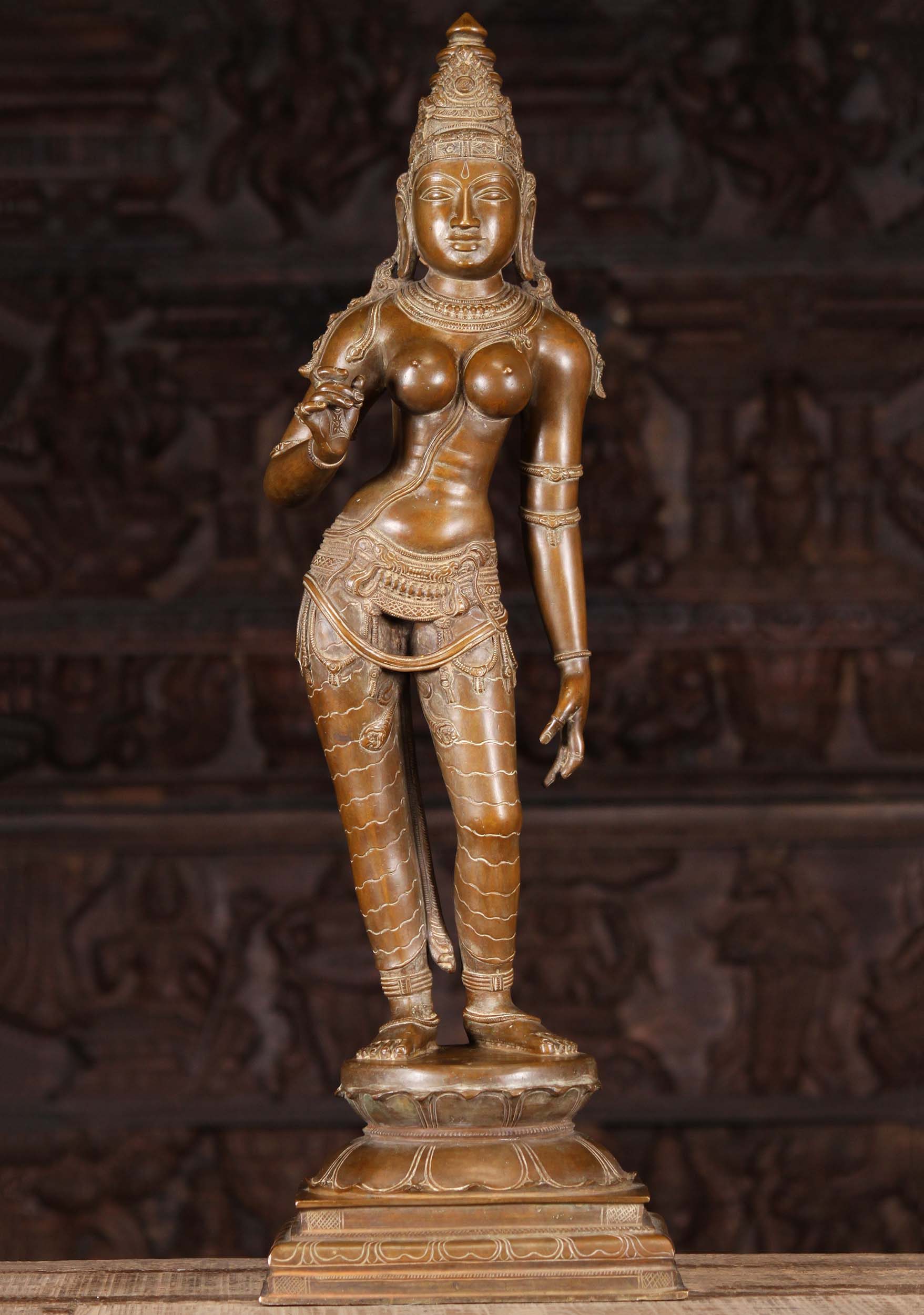
Margo says, “Mirza, she is quite voluptuous for a mother figure! And, pretty racy, don’t you think?”
“Yes, she is a mother, but also a goddess! You will also hear the Hindu term Yoni, which is often highly symbolized and has become quite popular in the West. It is the vulva or more loosely translated, womb, so, those statues don’t go in our schoolbooks.”
“Oh, we have Georgia O’Keefe with her “flower” paintings. Makes it impossible for high school art teachers to talk about her work. Can you talk about Parvati in schools here?”
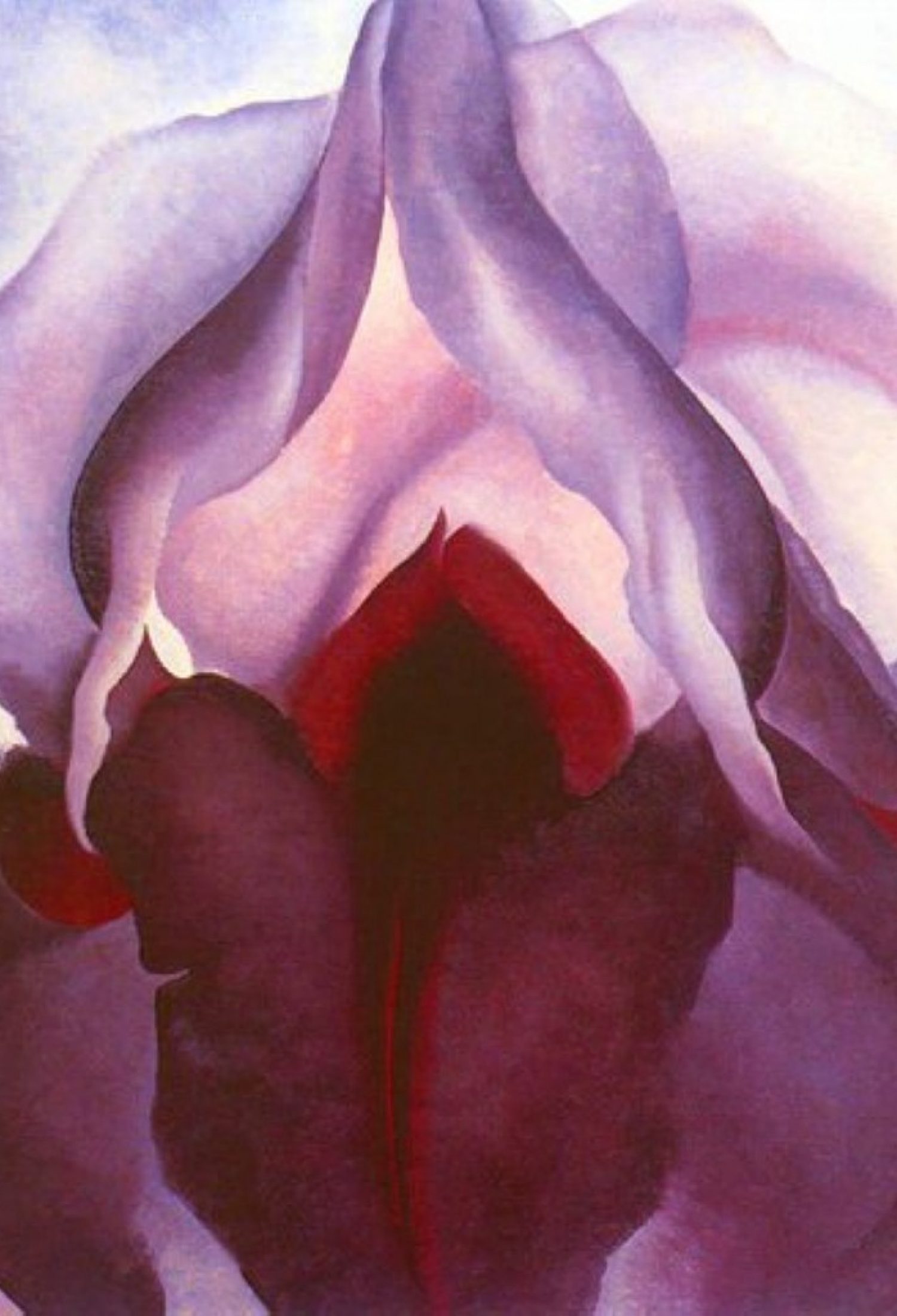
“Oh yes, they learn all about Parvati early on, but our sexy savior has over 100 Hindu names, each representing a different attribute of her strength and she takes many different forms in her role as a superhero destroying evil. She married Shiva, the prime deity in Hinduism, the destroyer of evil and regenerator of the universe and all life. She is said to “complete” his power, this was way before the Jerry Maguire movie.” Margo looks at him quizzically, surprised he knows that reference. “Yes, I watch US movies so I can better understand cultural references and lingo. I love “Show me the money!”
“That is sadly all you need to know about America,” Margo says. “I will quiz you later.”
Mirza turns his attention again to the statue and continues. “Shiva lost his beloved first wife, Sati when she threw herself into a fire.”
“Like Daenerys in Game of Thrones?” asks Margo, starting the quiz right away.
“Yes, kind of like that, but it did not work out so well for Sati and no baby dragons were produced. She had to do it to prove her innocence after being falsely accused of adultery. It is where we get the term “trial by fire”. Shiva was distraught by Sati’s death and never wanted to remarry. Many years later, he put the young Parvati, our deity here, through a different set of tests and was so impressed, he agreed to marry her.”
“What a romantic dude. No wonder you have lots of arranged marriages here.”
“I know!” says Mirza. “At one point, he turns Parvati into a peacock and demands that she worships him to regain her human form. She did so outside of the gate where we entered. Mylapore, the name of this part of the city, stands for The City of Peacocks, even though there are no peacocks here. I guess it worked out, because Parvati and Shiva had 3 children, including Ganesha, the remover of obstacles, the patron of arts and sciences and the deva of intellect and wisdom.
Mirza points to a statue of Ganesha, a big bellied human body with 4 arms and an elephant’s head sitting cross legged in a yoga position. One hand holds a Medieval ax, another a flower and the third a bowl of bonbons.
“This is Ganesha.”
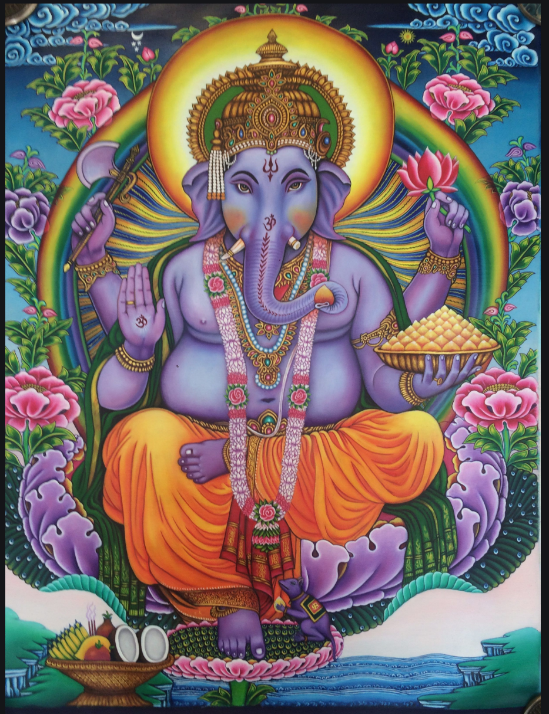
“What a romantic dude. No wonder you have lots of arranged marriages here.”
“I know!” says Mirza. “At one point, Shiva turns Parvati into a peacock and demands that she worships him to regain her human form. She did so outside of the gate where we entered. Mylapore, the name of this part of the city, stands for The City of Peacocks, even though there are no peacocks here. I guess it worked out, because Parvati and Shiva had 3 children, including Ganesha, the remover of obstacles, the patron of arts and sciences and the deva of intellect and wisdom.
“I’ve seen statues of him often. How did he come to have the elephant head?” Margo asks.
“He was guarding his mother who did not want to be disturbed while she was taking a bath. Shiva came home and told him to move.”
“I should think deities would be granted some diva time!” says Margo.
“Ganesha thought so too and wouldn’t move. So, Shiva cut his head right off. As you can imagine, this did not go over well with Parvati and she pleaded with Shiva until he sent his army out to find a new head for Ganesha. With time short, the best they could do was an elephant head. Every part of his body holds symbolism. For example, the trunk makes him highly efficient and adaptable, the big ears tell people to listen more. The big belly allows people to digest all of the good and bad in life. “
“I’ve always marveled at elephants. Trunks absolutely help remove obstacles and I also think it would be very, very handy to have one. People know they are prehensile – they’ve seen the elephants grabbing a log and moving it. But, people don’t usually know that the trunk gives elephants a sense of smell 4 times more acute than a blood hound’s. Talk about being able to sniff out problems! It has 40,000 muscles, and one or two little fingers at the end to grab items.” Margo puts out her arm and snatches at the air with two fingers extended. In response, Mirza puts his arm out and mimics her move, catching her fingers. Then, he turns back to Ganesha.
“Notice the tusks. The full one represents wisdom and the broken one represents emotions. The point there is that emotions must be controlled by wisdom,” Mirza says.
“I’m not sure I can tell the difference between my emotion and my wisdom right now. it could be the pregnancy or the stress. Maybe I need to huddle with Ganesha for a bit.”
Mirza starts laughing so hard he can’t quite talk for about 30 seconds. “Margo! You picked exactly the right god! People pray to him before starting any new endeavor.”
“Perhaps that is why you took me here, after all.” Margo says.
“Yes, perhaps the gods made me do it. But 100% of the women in your position, trying to make this decision, would be conflicted. “
“Now there is a stat that I believe!”
Margo and Mirza continue walking around with the ever growing column of kids at their heels. After a few more stops and discussions of various gods, the temple’s become so packed it’s hard to navigate and so hot that Margo’s pregnant feet bulge out of her shoes. Margo says, “This is beautiful and impressive, but I take up entirely too much space these days and I feel like I am going to get crushed – or bounced around like a beach ball. Besides, your following is beginning to creep me out.”
“Only 2% of the people who come here actually end up in the hospital, crushed. A bit higher during the festivals. However, I will save you if you agree to come to my house to meet my wife and children and have some tea. Keya can tell you about how she felt while making her decision about our children. I know your situation is a bit different. “
Margo thinks it would indeed be very handy to talk with a mother who went through the same evaluation she now faces. Besides, it would be interesting to see how a well to do, but not wealthy, Indian family lives. “I’d love to meet your family and ice tea is my beverage of choice for now, let’s go!”
